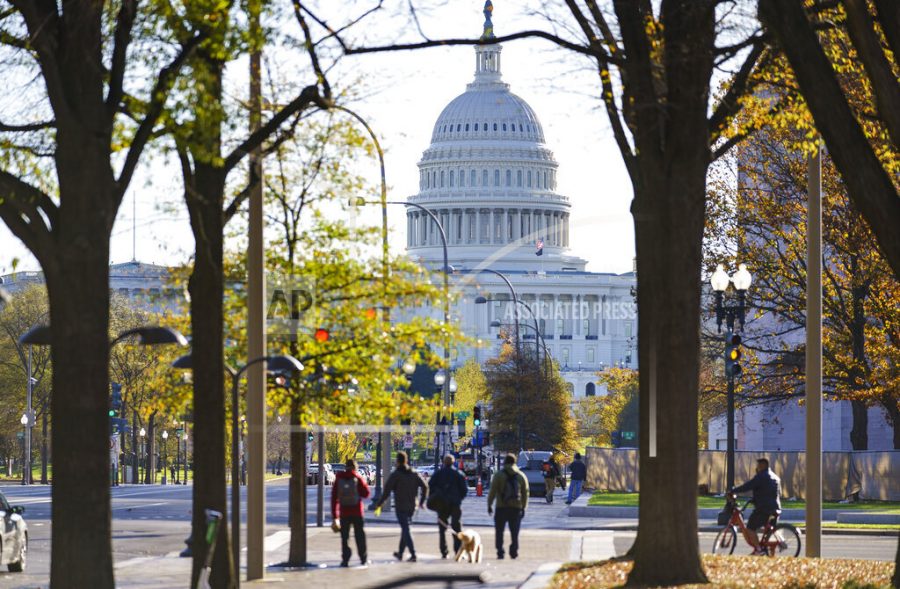The 117th Congress Sets Records in Diversity
The Capitol is seen in Washington, Monday, Nov. 16, 2020, as the House and Senate return to work. (AP Photo/J. Scott Applewhite)
Nov 18, 2020
Editor’s Note: As of Nov. 18, there are still Congressional races yet to be determined, so these numbers may increase.
The 117th Congress includes a record number of racially and ethnically diverse representatives along with an increase in congresswomen, now totalling 141, 51 of whom are women of color, according to the Rutgers Center For American Women and Politics. For comparison, using data from Congressional Research Service, the 116th Congress had 131 members of color, or roughly 24% of total membership.
The trend toward greater representation for racial and ethnic minorities in Congress has steadily increased over the past few years.
“In 2018, the nation elected 127 women — and 48 women of color — to the House and Senate,” according to an article reposted by AP News from The Conversation.
As for last year’s Congress, a 2019 article from Fact Tank reported, “More than one-in-five voting members (22%) of the U.S. House of Representatives and Senate are racial or ethnic minorities, making the 116th Congress the most racially and ethnically diverse in history.”
In this year’s Congress, “women will be at least 27% of the House and 24% of the Senate. … In total, 643 women were candidates in congressional primary elections, including a record number of Asian or Pacific Islander, Middle Eastern or North African and Native American women,” stated The Conversation. “Black women also set a new record in 2020 with 117 entering primaries for the House and 13 for the U.S. Senate.” In total, 25 Black women will serve in the 117th Congress, surpassing the record of 22 set in 2019.
Additionally, Congress will include 26 women who will be serving their first terms, according to results from the CAWP. In 2021, at least 17 Republican women will join the incoming class of new House members in the 117th Congress, exceeding the record of 9 in 2010, and massively improving over 2018, where one lone Republican joined the House. In the Senate, a record 24 women will be serving
Out of the 117 women who will be serving in the House, 91 women House incumbents won reelection this year, including four of its most prominent female members who are all women of color: Reps. Ayanna Pressley, D-Mass., Ilhan Omar, D-Minn., Rashida Tlaib, D-Mich., and Alexandria Ocasio-Cortez D-N.Y.
In the Senate, six incumbent women Senators won re-election, and one non-incumbent, Cynthia Lummis R-W.Y., was elected. She is the first woman elected to represent Wyoming, bringing the number of states that have never had a woman senator down to 17.
Though recent Congresses have been setting records for racial and ethnic diversity, many minorities are still underrepresented when compared with the overall U.S. population.
According to data from the U.S. Census Bureau, in 2019, 39.9% of the U.S. population were nonwhite, which broke down to 13.4% Black, 18.5% Hispanic or Latino, 5.9% Asian, 1.3% American Indian and Alaska Native, 0.2% Native Hawaiian and Other Pacific Islander and 2.8% two or more races.
In contrast, 79% of members of Congress are white, a much higher percentage than that of the 60% white U.S. population. Additionally, women make up 50.8% of the population but will only account for 24% of the House and 27% of the Senate.
In the 116th Congress, “at least 114 lawmakers [were] either African American, Asian or Hispanic, meaning that more than 1 in 5 lawmakers in the 116th Congress [was] a person of color and nearly 8 in 10 are white,” according to CNBC.
Though both chambers of Congress have become more diverse, populations in the U.S. are not yet proportionally represented by their elected representatives.
However, the 117th Congress remains the most diverse in the nation’s history, which bodes well for proportional representation as more minority candidates run and are elected to represent their constituents.













